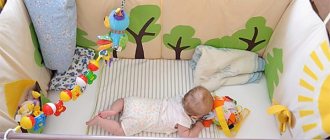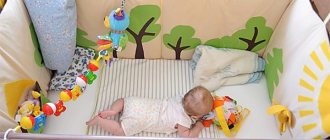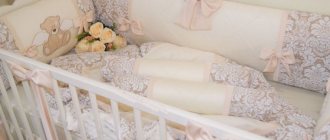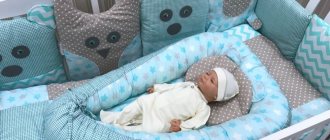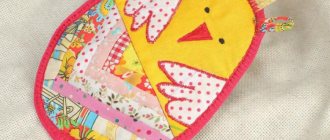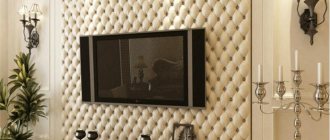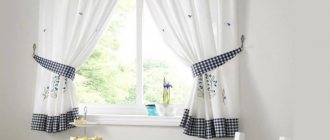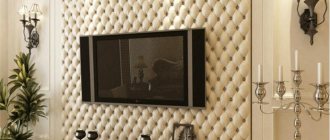The bumpers for cribs are a kind of fence that protects the baby. They perform several functions at once: firstly, they prevent the child from falling, secondly, they protect him from cold and drafts, and thirdly, they prevent him from injuring himself on the crib railing as a result of an unsuccessful movement. The price of bumpers in stores in most cases starts from 1,500 rubles. A little expensive, especially considering that after 1.5 years they will no longer be needed. Therefore, it is better to make the sides yourself. Let's talk about this in more detail.
Bumper in a crib for newborns - how to attach and tie pillows
You need to prepare in advance for the birth of a child and take all safety measures so that the newborn is not accidentally injured while in the crib.
The bumper for a baby crib is a seal that is attached using fasteners to the walls of the crib, and makes it soft and safe for the baby. This device is also called sides or protection. This kind of device can be four-sided, which completely blocks the entire space in the crib, thereby blocking the baby’s path to the edges of the sides on the bed. The protection can also consist of halves that cover only part of the space, thereby allowing the baby to explore the world around him.
Dimensions and safest height
Sides must be selected based on the age of the child. They can vary in length and aesthetic appearance. Sides that cover the entire length of the mattress are suitable for younger ages or for the second floor of the bed. If the second tier is intended for a teenager or an adult, it should be remembered that falls from the second floor are more likely than from a simple bed.
The height of the protective structure directly depends on the age of the sleeping person and can range from 20 to 90 cm. When installing a barrier on the second floor or for a teenager, a height of 20-30 cm is enough to protect against falling during sleep.
For children under one year old, the height of the rail should be at least 70 cm, and for increased safety the height can reach 90 cm. This height will prevent the child, who gets to his feet on his own, from falling and will not allow him to fall over the barrier. If a child does not know how to sit, then the safe height of the side is 30 cm; as soon as he has learned to sit up independently in the crib, then the limiter is increased to 50 cm in height.
Restrictors that do not cover the entire length of the mattress can also prevent falls during sleep. They are most often installed for preschool children or on the second floor of the bed. This side has a number of advantages. Firstly, the installation and lowering process will be easier. Secondly, it will be easier for a child to get into bed with this type of barrier than with one that covers the entire length of the mattress.
Decorative edges are mostly of an aesthetic nature and carry almost no semantic meaning. When installing such sides, you should not count on ensuring safety while sleeping, since they do not fulfill their protective function. When choosing a protective system for a small child, it is better not to rely on this type of barrier. And they can protect a teenager or an adult from falling in their sleep.
What is it needed for
Borders for the crib are necessary for parental concern for the baby. They will help eliminate the need to check the child several times a night, as well as from constant monitoring and distraction from household chores during the day. After all, when the baby is active, he can toss and turn, roll from one side to the other, and this is fraught with bruises. The bumper helps prevent the development of traumatic situations.
In the photo - a bumper in a crib for newborns:
Among other things, a child may roll over and hit the bed frame while sleeping or resting, which will contribute to his fear, moodiness and restlessness. With the bumper installed, this will not happen, and parents will be calm about the physical and mental health of their child.
Sides made on the basis of soft filler have gained considerable popularity. But do not forget that in addition to advantages, they have disadvantages. They are made in the form of pillows with ribbons, which are attached to any part of the crib and have certain functions.
For security
The main purpose of this protection is to protect the child from through blowing and all kinds of falls. If the crib is located near open sources of cold air, the installed side will serve as reliable protection from external factors.
Also, the bumper on the crib will not allow the baby to stick through its bars, which will help avoid getting stuck and bruised between them. A protective side, hung throughout the crib, promotes a peaceful sleep for the baby, since the fence can distract him from external irritants.
The disadvantages of a protective side for a baby, which is attached along the entire length of the bed, is that it blocks the outside world from the child, as a result of which every approach of the parents can frighten him. It is better to use only a partial bumper.
Read here for size standards for children's blankets.
For development and motor skills
An important component of the bumpers is its functionality, which will serve as a developmental factor for the baby. If you hang bumpers with printed drawings on the crib, the child will begin to develop faster and will be able to distinguish objects and details. Protective pillows of different colors will contribute to the child’s ability to quickly shift his gaze, and will also help develop concentration.
The main rule when buying bumpers is to choose not flashy colors with a small pattern, so as not to irritate the baby’s not yet fully formed eyeballs. Developmental boards are often equipped with different sound signals, light illumination, and small adhesive toys for training fine motor skills of the fingers.
Required tools and materials
In order to create bumpers for a newborn’s crib, you will need the following materials and tools:
- pattern;
- required amount of fabric and filler;
- scissors;
- needle.
If you have a sewing machine at home, you can use it for sewing.
Children's mattress
Fabric and fillings
A bumper on a bed for a newborn should consist only of natural fabrics, such as baby calico, chintz, synthetic padding. Natural quality fillings have a stitched seam that does not form lumps or unevenness, even after washing.
You should not purchase bumpers made of foam filling due to the high likelihood of developing allergies in children. Fillers with chemical fibers also tolerate washing well, but are not safe for children, so they should not be used.
Towels for newborns are made from natural materials.
How to choose a blanket envelope for discharge in the summer?
Step-by-step instruction
The work of creating a side for a crib can be divided into several stages:
- creating a pattern and preparing fabric in accordance with it;
- directly sewing and filling the finished product;
- decorating things.
Let's look at each of these stages in more detail.
Preparing and cutting fabric
Before you start working, you need to create patterns from thick paper. They should repeat the outlines of the pieces of fabric that will make up the future product. To avoid confusion with sizes, it is better to download pattern layouts on the Internet and then transfer them to paper.
Fastening rules
The bumper can be easily attached to any type of crib, as they have fasteners in the form of ribbons, zippers, buttons or Velcro. After attaching the side, you need to make sure that the fasteners are secure.
The dimensions of the protective sides of a standard 140x70 crib are individual and have their own dimensions for each side. Before purchasing a bumper, you should consider the size of the crib.
Protective sides must consist of an anti-allergenic coating and real silicone filler. If you are not sure about the composition and material of manufacture, you should refuse the purchase.
Existing types of bumpers for newborns
There are several types of bumpers:
- With removable covers. They allow you to often change the color scheme of the crib, but are quite inconvenient in terms of care. There are usually 12 pillows in a crib, which means that a new mother will need extra time to remove old ones and replace new ones. In addition, each pillowcase will have to be ironed and steamed.
- Stitched sides. The most convenient option, as they do not require special care and save a sufficient amount of time. These sides easily fit into the washing machine and do not get knocked down or crumple.
- Flat sides. A good alternative to bulky pillows, they are suitable for small beds, as they do not take up much space and have a regular rectangular shape.
- Bombon sides. One of the varieties of flat sides, characterized by a more relief structure.
- Toy pillows. One of the popular options for decorating cribs. Side in the shape of a cloud, owl, etc. It not only allows you to decorate a child’s sleeping place in an original way, but can also become a favorite toy at an older age.
Important! You need to wash not only the pillowcases, but also the sides themselves, since dust still penetrates into the pillow through the fabric.
Damage to soft crib bumpers
Despite the advantageous qualities of bumpers for cribs, there are a number of negative factors:
- When hanging the protective sides, dust accumulates inside, which has a harmful effect on the development of the baby’s pulmonary system.
- Sides made of soft fillers do not allow the child to breathe fresh air, and as a result, the lungs and brain vessels suffer.
- This device prevents the baby from observing what is happening around, and the parent from observing the child.
How to make sides for a crib with your own hands
The baby's crib must be protected with special bumpers. These products look like a kind of soft pads that are attached to the head of the crib and its sides. They perform many functions, protecting children from injuries, bruises, as well as drafts and other surprises. Making a border yourself is very simple, even if you have absolutely no experience in sewing. Crib bumpers can be an excellent and valuable gift for the birth of a baby.
We decide on the type, style, size
First, you need to decide on the design features of the product and understand the complexity of its tailoring. There is a wide variety of their types and forms. Each of them has its own pros and cons. Thus, the covers can be high, completely isolating the baby from the outside world, and low, only partially covering the bars of the crib. There are sides with replaceable covers in the form of pillowcases. The advantage of such a set is the possibility of frequent change and washing.
The following main types of sides are distinguished:
- a solid side that runs along the entire perimeter of the crib;
- pads in the form of pillows attached to the crib with ties;
- classic version, consisting of four covers for all sides of the crib.
ATTENTION! An interesting option are products with pockets on the outside of the crib. Their contents will always arouse the keen interest of the child.
Choosing fabric and filling
Choosing suitable materials for sewing children's clothes is a very important undertaking. It is best to use cotton fabrics. These are natural and hypoallergenic materials that are very pleasant to the touch, as well as easy to wash and iron. Most often, craftswomen choose calico, satin or flannel. Particular attention should be paid to the density of the fabric: it should not be very thin so that the filler does not show through. Various materials can be used as filler. The following types are most in demand:
- Foam rubber is a microfiller and requires special recommendations when washing, because... holds water well and dries for a long time.
- Holofiber is excellent for dense and voluminous overlays. It is non-toxic, dries quickly and regains its shape.
- Holcon is an artificial filler and is used mainly for flat and soft products. It also has unique heat resistance and high performance characteristics.
- Synthetic winterizer is one of the best fillers. It is easy to use, washes well, dries instantly, and is also inexpensive.
It is better to use satin or grosgrain ribbons up to 3 cm wide as ties.
Examples of patterns
Most patterns are focused on the usual crib configuration with dimensions of 120 cm in length and 60 cm in width. Therefore, before starting work, you should check the dimensions of the furniture in order to make adjustments if necessary. The height of the sides is not regulated and is determined by the personal wishes of the parents.
The most popular patterns are made from pillows. The usual size is 30-32 cm. Usually 4 elements are used on the long sides and two on the short sides. 8 (in this case, one side remains open) or 12 pillows can completely cover the perimeter of the crib. Also, a few centimeters are added to the indicated dimensions for processing the seams. Therefore, it is better to cut 35 cm squares. So, if the width of the fabric is one and a half meters, then you can fit 4 elements in a row and sew 2 pillows in this way. To completely furnish the perimeter of the crib you will need about two meters of fabric. The size of the pads can be increased up to 40 cm on each side. By increasing their height, you can make rectangular high sides. This will increase fabric consumption.
REFERENCE. In most cases, patterns are drawn directly onto the fabric using tailor's chalk or a bar of soap.
Instructions
Before starting work, a piece of fabric should be washed or treated with a steam generator so that it shrinks. The easiest way to sew pillows without covers. First, the necessary parts are cut out, and the filler is also cut. The resulting fabric parts are folded right side inward and three sides are sewn completely, and the fourth only 5-7 cm from each corner. It is important not to forget to sew ribbons or ties that will secure the pillow. The ribbons are sewn in immediately, so before joining the parts, they are placed in their places and secured with pins or a couple of stitches. To ensure reliability, the attachment points are stitched again on the machine. Next, the product is turned right side out, the filling is placed inside, and the unstitched edge is sewn up manually with a needle.
Varieties
Depending on the intended purpose of the side, structures of different heights, configurations, fastening methods and degrees of protection are used. In cribs for babies, it is recommended to use restraints that completely cover the side or long side of the bed. For preschool children, protective systems are installed to protect them from accidentally falling out of bed during night or daytime sleep. They may not be installed along the entire perimeter of the bed, but cover only part of the long side of the mattress.
In order to ensure convenience for the child and parents, the restraints are made removable or with the ability to be lowered down. This will help your baby climb into the crib safely.
Often, a bed restraint is available with a mount that allows you to easily remove the unit from a child's bed and attach it to any other horizontal surface that requires restraint. These bumpers are convenient to use when moving, traveling, and in cases where the child needs to sleep outside of his usual bed. This installation is easy to install and will protect the child even if he sleeps on an adult bed.
All types of bed bumpers to prevent falls are divided into several categories, depending on the material of manufacture:
- Soft;
- Made from mesh-like material;
- Plastic;
- Wooden.
Soft
Soft bed bumpers are made of padding polyester material or foam rubber. A layer of this material is rolled into tubes and fastened together so that the resulting structure is stable and indestructible. By adjusting the number of rollers stacked on top of each other, sides of different heights are made.
In order for such limiters to always look clean and neat, they are covered with covers with a removable snake. The covers are washed in the machine, ironed and put back on foam rollers. This will help to always keep the children's bed clean and the room beautiful.
In order for this design to adhere well to the bed, foam rollers, fastened together, are attached to the mattress. For this, homemade ties, buttons or sew-on zippers are used. Another simple do-it-yourself fastening option is sewing Velcro onto the bed restrainer and onto the mattress. Velcro fastening is one of the most reliable, but at the same time easy to use and operate methods of attaching foam bumpers to a mattress.
Net
A bed limiter made of mesh material is used for cribs if the child is not too small and sleeps separately from his parents. The mesh must be very strong and can support the child if he rests his entire weight on it while sleeping. To securely fasten such protection, you should prepare a frame for the mesh and securely fasten it. The frame is made of wooden slats or metal stops. The restraints themselves are softened by putting fabric covers or foam pillows on them.
This baby bed barrier allows your baby to see what's going on in the room. Thanks to the breathability of the mesh material, fresh air has free access to the baby's bed, which makes his sleep safer, healthier and more sound.
Plastic
Plastic protective barriers for beds come in two types:
- Purchased;
- Made by yourself.
The sides, made of plastic, have fairly high strength, combined with the low weight of the protective installation itself. Commercially available plastic restraints have an original set of necessary fittings for attaching the system to the bed.
When making such a system yourself, you can use available materials, such as plastic pipes for plumbing. They are very easy to fasten together, and thus create a side with vertical slats. The height of the slats is adjusted depending on needs and desires, the width of the holes between the slats - depending on the intended purpose of the side. The plastic bed barrier for children is very light, and there is no need to put soft covers on it. But if such a bed barrier is made of plumbing pipes, for ethical reasons it is covered with a cover or a thin blanket.
Wooden
Wooden restraints are the most popular and are often sold complete with cribs. The main advantage of a wooden stopper is that it is durable, versatile, and also that it fits any interior design. In addition, this installation is easy to wash, remove, and is completely safe for the baby. A wooden bed rail can be made in different designs, have different heights and fastening methods. Wooden barriers are not only used for cribs; they can be used as a removable barrier option for teenage or bunk beds.
Tips for creating baby crib bumpers
The easiest to manufacture and inexpensive option are sides made of cotton materials with synthetic padding. It's better to make two sets at once. This is very convenient, because while one of them is being washed, you can use the other. When sewing products yourself, you can show your imagination and come up with an interesting design. There is also an opportunity to experiment with color, which plays a big role in the development of the baby.
IMPORTANT! When making sides, you should take into account the fact that fastenings in the form of Velcro and ties may not hold up and tear when the baby plays and tries to stand up. It is better to sew the ties for fastening the overlays from a single piece of fabric; the raw edges are simply folded so that they are in the middle. Then only one seam is sewn along the edge of the tie.
Thus, sewing bumpers for a children's bed with your own hands is quite simple. It is better to use ordinary rectangles as patterns without using elements that complicate the design. We hope that this article was useful and will help you decorate your baby’s crib in an interesting way.
How to choose fabric
The choice of fabric for bumpers that you plan to make yourself must be approached responsibly. It must meet several criteria on which the comfort and health of the child depend. Here they are.
- Softness. Textiles should be soft. Under no circumstances should it rub the baby’s skin or cause him any discomfort when touched.
- Hypoallergenic. Under no circumstances should the fabric cause allergic reactions in the child. Many synthetic or semi-synthetic materials suffer from this, so for sewing it is better to give preference to natural textiles.
- Color. At first glance, this is not the most important parameter. However, with bright sides, on which interesting drawings will be applied, the baby will have much more fun. For girls, soft, warm colors (for example, pink, light purple) are more suitable. For a boy - more contrasting and dark (blue, red, green).
The following types of fabrics best meet the listed criteria:
- natural cotton;
- calico;
- flannel;
- chintz.
It can also be sewn from linen. However, it must be selected very carefully. Linen has a rather rough texture that can cause discomfort for the little crib occupant. To create a side it is necessary to select the material where it is least expressed.
How to sew bumpers for a baby crib: two simple ways
Soft sides or “bumpers” for a crib are a practical and necessary accessory that will protect the baby from unexpected injuries and protect him from drafts.
Soft rim made of 4 parts
You will need:
- Cotton in three colors: for external and internal parts of the sides, as well as for the ties;
- Sintepon;
- Scissors;
- Sewing thread and needle;
- Tape measure;
- Tailor's pins
DIY envelope for a newborn
Step 1
Measure the crib around the perimeter and write down the length and width of the crib, as well as the height of the side.
Step 2
From cotton of two different colors, cut out 4 rectangular pieces with a size equal to the length of the crib and the height of the side.
And 4 side parts equal in size to the width of the crib and the height of the side.
